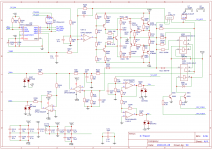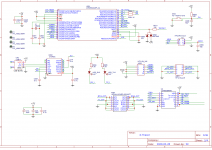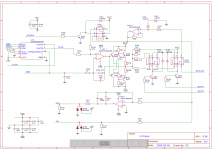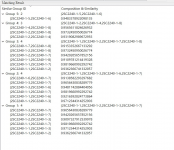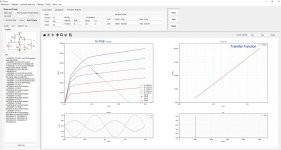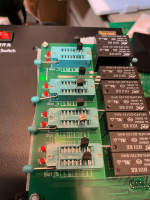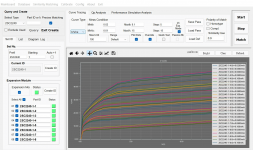Hi,Windows only? Will the source code be open?
Sorry for late reply.
According to the author, it's Windows only and not open-code.
Is there any consideration taken for thermal mass? Pulsed measurements? It is difficult to take pulsed measurements with enough accuracy for meaningful distortion analysis.
Yep, Linux support would be nice. The software screenshots look like Python, which has some nice cross-platform GUI packages available. It should be relatively straight forward to provide non-Windoze versions of the software. I'd also like to see a Linux software, as I am not a Windows person (and macOS is long gone for me).
For all those who need a curve tracer that runs on Linux, see here: https://github.com/mbrennwa/PyPSUcurvetrace
For all those who need a curve tracer that runs on Linux, see here: https://github.com/mbrennwa/PyPSUcurvetrace
Well I think "Windows only" is just for now, because everything is just under development.
After it's getting more mature, we could have spare time and effort to make to Linux-compatible.
Interestingly, I am also interested in PyPSUcurvetrace, but it's Linux based, although I've ever make suggestion that it's better to make it Windows compatible yet seemed no response.
Also X-tracer and PyPSUcurvetrace is very different, that's why I making effort in this tracer, because I am a Windows guy.
After it's getting more mature, we could have spare time and effort to make to Linux-compatible.
Interestingly, I am also interested in PyPSUcurvetrace, but it's Linux based, although I've ever make suggestion that it's better to make it Windows compatible yet seemed no response.
Also X-tracer and PyPSUcurvetrace is very different, that's why I making effort in this tracer, because I am a Windows guy.
PyPSUcurvetrace is not "Linux based". It's just Python, which is cross-platform.Well I think "Windows only" is just for now, because everything is just under development.
After it's getting more mature, we could have spare time and effort to make to Linux-compatible.
Interestingly, I am also interested in PyPSUcurvetrace, but it's Linux based, although I've ever make suggestion that it's better to make it Windows compatible yet seemed no response.
Also X-tracer and PyPSUcurvetrace is very different, that's why I making effort in this tracer, because I am a Windows guy.
Get some test results today.
I used 2SC2240 X8 and the Expansion Module, and the result is good.
The device automatically switch the DUT, up to 8 pcs at a single test is allowed, this is convinient for amateur use.
There's also ingetrated mathematical algorithem to calculate the similarity of each pair, and the software would tell you the similarity as numbers, eg. 0.96(96%).
Further, the simulation analyzer works. There is a basic template circuit, by setting the working point and some other parameters, it gives you THD, Gain, the output waveform, and.....FFT!
The system is under development still, so any suggestions are welcomed. Our goal is to make a affordable, yet powerful component tracing, matching system for amateur DIY users.
Yet, due to global IC shortage, the cost rises dramatically, some ICs are selling for 2X or 3X, this drags our plan.
I used 2SC2240 X8 and the Expansion Module, and the result is good.
The device automatically switch the DUT, up to 8 pcs at a single test is allowed, this is convinient for amateur use.
There's also ingetrated mathematical algorithem to calculate the similarity of each pair, and the software would tell you the similarity as numbers, eg. 0.96(96%).
Further, the simulation analyzer works. There is a basic template circuit, by setting the working point and some other parameters, it gives you THD, Gain, the output waveform, and.....FFT!
The system is under development still, so any suggestions are welcomed. Our goal is to make a affordable, yet powerful component tracing, matching system for amateur DIY users.
Yet, due to global IC shortage, the cost rises dramatically, some ICs are selling for 2X or 3X, this drags our plan.
Attachments
early voltage? Do you mean Ic-Vce while Vce<5V or so?Can you plot early voltage vs Vce?
No, I mean plot Early voltage at each Vce. It drops in quasi-saturation and when approaching voltage breakdown.
Yes, I must admit it, however it's a novel function that's under development, so, consider it a "bonus"; but it will get better for sure.Looks quite good. Although the linear FFT scale makes that plot pretty much useless.
Jan
Right now the software work is huge so we are mainly making sure the basic and fundamental function work well, and step by step improve the software.
I have pass your ask to the engineer, please wait for a while.No, I mean plot Early voltage at each Vce. It drops in quasi-saturation and when approaching voltage breakdown.
Sorry, the software is not able to do this right now, but it's possible to export data and plot it using Excel.No, I mean plot Early voltage at each Vce. It drops in quasi-saturation and when approaching voltage breakdown.
Inspired by uTracer, which is a tube tracer, we are considering to make the iTracer semi-open-sourced.
In this way, the tracer might get lots of help and improvement from the community (see the 3rd-party ESP32 of uTracer!), making it more powerful.
There are some ordering methods we've be thinking
A) Full PCB+MCU kit
PCB Assembled + pre-Programmed MCU
B) PCB+MCU
Bare PCB+pre-Programmed MCU, you can choose better components like lower TempCo. resistors, better V-Ref, low-ESR caps...etc.
C) MCU only
pre-Programmed MCU that is easy for delivering, and DIYers can design their own PCB and build up the chasis.
For extreme, professional DIYers who can make PCB and assemble the case with it, and even develop their own firmware, UI, and add more functions.
Schematic and/or PCB files might be open-sourced under these mode. The GUI software could be bundled with each MCUs. Website for iTracer is now under developement, and I am still working for stuff like hardware adjustment, software optimization, and writing manual.
Any thoughts and comments are welcomed.
Best Regards,
Jen
In this way, the tracer might get lots of help and improvement from the community (see the 3rd-party ESP32 of uTracer!), making it more powerful.
There are some ordering methods we've be thinking
A) Full PCB+MCU kit
PCB Assembled + pre-Programmed MCU
B) PCB+MCU
Bare PCB+pre-Programmed MCU, you can choose better components like lower TempCo. resistors, better V-Ref, low-ESR caps...etc.
C) MCU only
pre-Programmed MCU that is easy for delivering, and DIYers can design their own PCB and build up the chasis.
For extreme, professional DIYers who can make PCB and assemble the case with it, and even develop their own firmware, UI, and add more functions.
Schematic and/or PCB files might be open-sourced under these mode. The GUI software could be bundled with each MCUs. Website for iTracer is now under developement, and I am still working for stuff like hardware adjustment, software optimization, and writing manual.
Any thoughts and comments are welcomed.
Best Regards,
Jen
Last edited:
So, I am working on the PCB for international users, and there're something I want to improve/change.
The first thing is Vref, the voltage reference, early version uses internal Vref of the DAC; but I think adding LTC6655 (LCC-8) and MAX6225 (SO-8) provide better performance for the system, and it's up to the usesers choice. Also, the MAX6225's pinout is very common, many other Vrefs with SO-8 footprint are compatible.
Would it be a good idea to replace the original Ib-Vg channel amplifier with buffers like BUF634? The discrete versus IC.
- Home
- Design & Build
- Equipment & Tools
- New Tracer is coming
